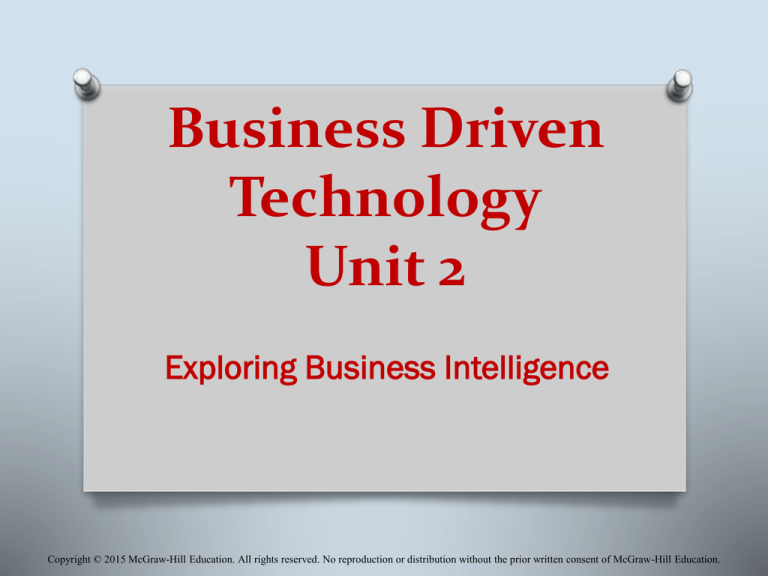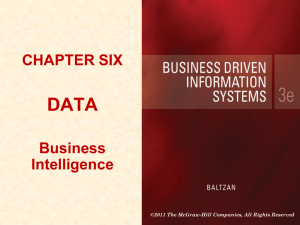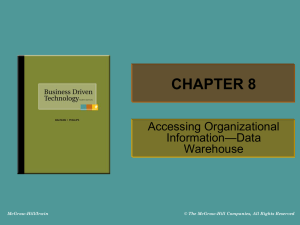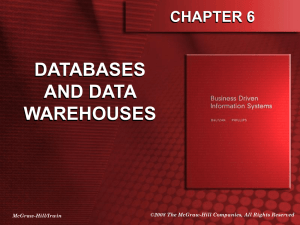
Business Driven
Technology
Unit 2
Exploring Business Intelligence
Copyright © 2015 McGraw-Hill Education. All rights reserved. No reproduction or distribution without the prior written consent of McGraw-Hill Education.
Unit Two
O Chapter Six – Valuing Organizational
Information
O Chapter Seven – Storing Organizational
Information – Databases
O Chapter Eight – Accessing Organizational
Information – Data Warehouse
8-2
Chapter 8
Accessing Organizational
Information—Data Warehouse
8-3
LEARNING OUTCOMES
1. Describe the roles and purposes of data
warehouses and data marts in an organization
2. Identify the advantages of using business
intelligence to support managerial decision
making
8-4
History of Data Warehousing
O Data warehouses extend the
transformation of data into
information
O In the 1990’s executives became
less concerned with the day-to-day
business operations and more
concerned with overall business
functions
O The data warehouse provided the
ability to support decision making
without disrupting the day-to-day
operations
8-5
Data Warehouse Fundamentals
O Data warehouse – a logical
collection of information – gathered
from many different operational
databases – that supports business
analysis activities and decisionmaking tasks
O The primary purpose of a data
warehouse is to aggregate
information throughout an
organization into a single repository
for decision-making purposes
8-6
Data Warehouse Fundamentals
O Extraction, transformation, and loading
(ETL) – a process that extracts information
from internal and external databases,
transforms the information using a common
set of enterprise definitions, and loads the
information into a data warehouse
O Data mart – contains a subset of data
warehouse information
8-7
Data Warehouse Fundamentals
8-8
Multidimensional Analysis
and Data Mining
O Databases contain information in a
series of two-dimensional tables
O In a data warehouse and data mart,
information is multidimensional, it
contains layers of columns and rows
O Dimension – a particular attribute of
information
8-9
Multidimensional Analysis
and Data Mining
O Cube – common term for the representation of
multidimensional information
8-10
Multidimensional Analysis
and Data Mining
O Data mining – the process of
analyzing data to extract information
not offered by the raw data alone
O To perform data mining users need
data-mining tools
O Data-mining tool – uses a variety of
techniques to find patterns and
relationships in large volumes of
information and infers rules that predict
future behavior and guide decision making
8-11
Information Cleansing or
Scrubbing
O An organization must maintain high-quality
data in the data warehouse
O Information cleansing or scrubbing – A
process that weeds out and fixes or discards
inconsistent, incorrect, or incomplete
information
8-12
Information Cleansing or
Scrubbing
O Contact information in an operational system
8-13
Information Cleansing or
Scrubbing
O Standardizing Customer name from
Operational Systems
8-14
Information Cleansing or
Scrubbing
O Information cleansing activities
8-15
Information Cleansing or
Scrubbing
O Accurate and complete information
8-16
Business Intelligence
O Business intelligence – information that
people use to support their decision-making
efforts
O Principle BI enablers include:
O Technology
O People
O Culture
8-17
The Problem: Data Rich,
Information Poor
O Businesses face a data
explosion with digital images,
email in-boxes, and
broadband connections
O The amount of data generated
is doubling every year
O Some believe it will soon
double monthly
8-18
The Solution: Business
Intelligence
O Improving the quality of business
decisions has a direct impact on
costs and revenue
O BI enables business users to
receive data for analysis that is:
O Reliable
O Consistent
O Understandable
O Easily manipulated
8-19
The Solution: Business
Intelligence
BI Can Answer Tough Questions
8-20
Visual Business Intelligence
O Informing – Accessing large amounts of data
from different management information
systems
O Infographics – Displays information graphically
O Data visualization – Allows users to “see” or
visualize data to transform information into a
business perspective
O Data visualization tools – Sophisticated analysis
techniques such as pie charts, controls,
instruments, maps, time-series graphs, and
more
8-21
LEARNING OUTCOME REVIEW
O Now that you have finished the
chapter please review the learning
outcomes in your text
8-22










